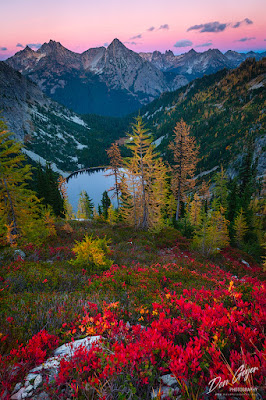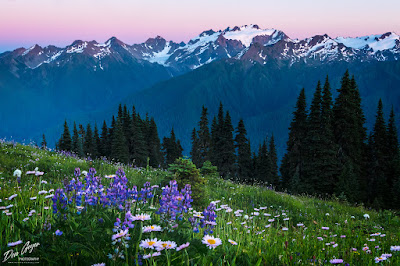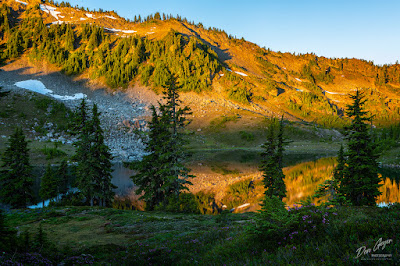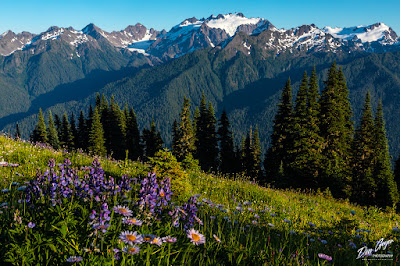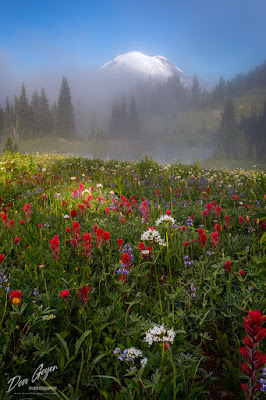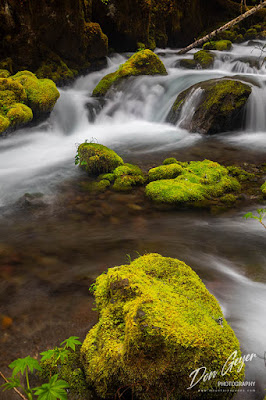This trip was my introduction to the Sawtooth Wilderness of Idaho, so I wasn't really sure what to expect, other than great scenery. I was not disappointed to find there was so much more!
It was a nearly 10 hour drive from Seattle, with much of it on two-lane country and forest service roads to the small town of Stanley. It was a pretty crazy place at 3:00 in the afternoon, with gas station lines up to seven cars deep! I would highly recommend gassing up and securing your provisions along the way (elsewhere).
I arranged to meet Brian of Sawtooth Transportation at the Redfish Lake TH. There I would leave my vehicle and be shuttled by Brian to the Pettite Lake TH to begin my one-way backpack. Brian was awesome and I highly recommend his company if a shuttle is in your plans!
 |
Alice Lake Reflection.
|
We arrived at the Pettite Lake TH around 4:00 pm, and I began to weigh my options for the evening. My hope was to camp at the TH for an early morning start, but this was not an option. So I got my gear together and began hiking up the Alice Lake trail in search of a place to call home for the evening. I found one just past the trail register, about a mile in at the far end of the lake.
I didn't get much sleep that night however. While the lake sports a campground and day use area on this side, the other side consists of summer vacation homes, and the parties went late.
The next morning I got a 7:00 am start up the trail, hoping to arrive at Alice Lake late enough to allow sites to empty, but early enough to snag a nice site. It worked. I arrived as the last party left the coveted peninsula, and snagged a site at the far tip with fantastic views of the peaks across the water. This area began to fill up as the afternoon went on.
 |
| Phone pic of Twin Lakes from Snowyside Pass. |
I would probably do things differently next time. There are some beautiful sites at the foot of the lake. The lake water had a foul taste to it, despite my filtering it. I soon discovered that one did not have far look to find toilet paper about. How I am not certain as there is no privacy at these sites. One has to walk quite away to conduct one's business.
If I have one complaint about the Sawtooths, it's the lack of waste management. Their are no pit toilets, even in the most popular areas. This is compounded with the fact that established campsites are commonly within 10 feet (or less) of the water.
After setting camp and resting, I went up and scouted Twin Lakes. Very nice. Not nearly as crowded.
I awoke a couple of times during the night to photograph the Milky Way, then awoke early for sunrise. The previous day had been quite windy all day long at the lake. But morning brought beautifully still waters that offered the anticipated reflection of the surrounding peaks.
My plan was to head to Imogine Lake this day, but I soon realized it was not going to happen. I stayed too late in the morning at Alice Lake for photography, and I hadn't adjusted to the elevation yet. Coming from sea level, ~9,000' was quite an adjustment. I huffed all the way up to Snowyside Pass and realized Toxaway Lake would have to do.
 |
Phone pic of Toxaway Lake from the trail to
Sand Mountain Pass.
|
Toxaway Lake was very crowded. It proved to be a popular destination for fishermen, boy scouts, church groups - you name it. Finding a campsite at noon was a challenge.
I set camp and again spent the afternoon resting. While re-evaluating my itinerary, I came to the conclusion that my next day's destination - Imogine Lake, was not going to work out. I would have to follow it by hiking all the way from Imogine to Cramer Lakes (13+ miles and climbing over two 9,000' plus passes) the next day to keep my schedule, which I was not confident I could do. Falling short likely would mean sacrificing Baron Lakes, which I was not willing to miss out on.
So I awoke early the next morning and began the climb up to Sand Mountain Pass. I felt much better and even had a hop in my step, which put a smile on my face. It was going to be a good day!
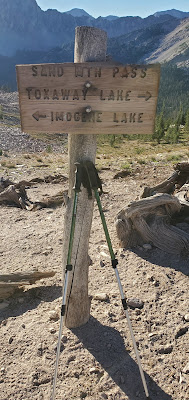 |
Phone pic at Sand
Mountain Pass. |
Sand Mountain Pass was awesome! I enjoyed a nice break before beginning my descent down to Edna Lake.
Edna Lake was beautiful and mostly vacant. Lots of nice campsites. I traversed its shores and continued descending the south fork of the Payette River.
Somehow, I missed the trail junction with the Hidden Lake trail. I was about 1.5 miles past it when I realized this and had to backtrack. As frustrating as it was, I had to laugh. I realized this was going to put my day's mileage above 13 miles - the number I was trying to avoid! But I felt good about myself and confident.
I arrived at Hidden Lake in not much time and stopped for a break. I've often heard of the Sawtooth range being compared to the Sierras of California. But honestly, many areas actually remind me more of the Wind River range of Wyoming. This was one of them.
The climb from Hidden Lake up to Cramer Divide was a grunt, mostly toward the top. At 9,500', this would be the high point of my entire trip. It was beautiful.
The descent down the backside to Cramer Lakes was steep. I can't say I would want to have to ascend this route, especially on a hot day.
 |
Upper Cramer Lake Reflection.
|
I didn't know much about Cramer Lakes. They were supposed to be a layover stop for me on my way to Alpine and Baron Lakes. Little did I know just how beautiful they were!
Despite this day being my longest of the trip, I had no problem finding a nice campsite on the isthmus between the upper and middle lakes. The views were quite nice, and evening brought some very special light and calm waters on the lake.
I met a group of guys from Portland here, who were basically doing my trip in reverse. We chatted off and on throughout the afternoon.
 |
Upper Cramer Lake Reflection.
|
The next morning I got an early start on my descent to Flatrock Junction. The ford of Redfish Creek was very straight forward, and I set my sights on the steep climb to Alpine Lake.
I wasn't sure what to expect at Alpine Lake, other than the crowds. Everything I read and heard was that it was a very popular place, and one should seek solitude elsewhere. Apparently the crowds did not get the memo as I arrived to find it deserted! I set up camp and had the entire campground to myself until 6:00 that evening, when another group finally showed up. We were the only two parties for the night.
The day was quite windy and it was evident that there was a change in the weather. That night I heard the pitter patter of rain drops on my tent for the first time. It didn't last long, however.
 |
Morning light above Alpine Lake
|
I awoke to some clouds in the sky and wind on the lake. There would be no morning reflection, but there was still some nice light.
I soon packed up and hit the trail for Baron Lakes on the other side of the divide.
The views from the divide were excellent and soon I was descending down to Baron Lakes. Upper Baron Lake was quite nice and sported some awesome campsites just off the trail. But I continued down to Baron Lake itself, and was thankful I did. I arrived to find I again had the campground all to myself and would for most of the day, only eventually sharing it with one other party.
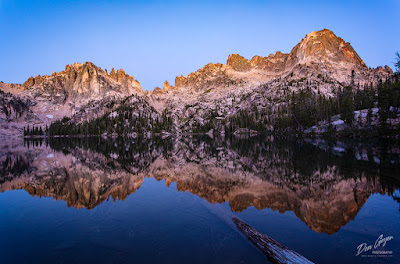 |
Baron Lake reflection before sunrise.
|
There had been some excitement in this area prior to my arrival. The day before I began my trip, a 4.3 earthquake hit the area. The earthquake triggered the summit of Baron Peak to fall off the mountain! You can see in the picture to the left (and below) white streaks on the peak to the right. This is where all the rock slid down the mountain. Two different parties captured much of the event on video. You can easily find it on YouTube.
I found Baron Lake to be spectacular and my favorite lake of the entire trip. I spent the afternoon wandering around and scouting for photography. Again I got up several times during the night for star photography. This was the coldest night of my trip, with the temperature dipping down to 37 degrees F - in August. The temperature range in the Sawtooths were quite extreme during my trip. Daytime temps were commonly in the 80's, but nights would be in the low 40's.
 |
Baron Lake Reflection.
|
Morning found a beautiful reflection on the lake that I couldn't get enough of! I scampered around for different compositions as the light increased on the peaks above, eventually realizing the best was behind me and it was time to move on.
This was my exit day. I would backtrack over the divide back to Alpine Lake, Flatrock Junction, and descend down to Redfish Lake to catch the water taxi across the lake and back to my vehicle. Only the section past Flatrock Junction would be new to me.
As I descended, I was amazed at the amount of uphill traffic going to Alpine and Baron Lakes. I began to realize that the solitude I got to experience may have been the exception to the rule, and considered myself lucky.
 |
Baron Lake Reflection.
|
I arrived at the dock just in time to see the water taxi making its way across the lake toward me. My trip was done - 47.2 miles and 6 days later, and many memories.
As always, thanks for looking and I hope to see you on the trail!











